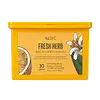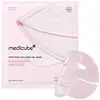What's inside
What's inside
 Key Ingredients
Key Ingredients

 Benefits
Benefits

 Concerns
Concerns

 Ingredients Side-by-side
Ingredients Side-by-side

Water
Skin ConditioningGlycerin
HumectantMethylpropanediol
SolventNiacinamide
SmoothingPanthenol
Skin ConditioningSodium Hyaluronate
Humectant1,2-Hexanediol
Skin ConditioningHydroxyacetophenone
AntioxidantCarbomer
Emulsion StabilisingTromethamine
BufferingAllantoin
Skin ConditioningTrehalose
HumectantAdenosine
Skin ConditioningXanthan Gum
EmulsifyingDisodium EDTA
Sodium Acetylated Hyaluronate
HumectantHydrolyzed Hyaluronic Acid
HumectantHydrolyzed Sodium Hyaluronate
Skin ConditioningHyaluronic Acid
HumectantHydroxypropyltrimonium Hyaluronate
Potassium Hyaluronate
Skin ConditioningSodium Hyaluronate Crosspolymer
HumectantCentella Asiatica Root Extract
Skin ConditioningCentella Asiatica Extract
CleansingCentella Asiatica Leaf Extract
Skin ConditioningMadecassoside
AntioxidantAsiaticoside
AntioxidantAsiatic Acid
Skin ConditioningMadecassic Acid
Skin ConditioningPortulaca Oleracea Extract
Skin ConditioningAloe Barbadensis Leaf Water
MaskingCymbopogon Schoenanthus Extract
Skin ConditioningCitrus Aurantifolia Peel Extract
CleansingMentha Suaveolens Leaf Extract
AstringentCandida/Garcinia Cambogia Ferment
Hydroxypropyl Cyclodextrin
MaskingMyrica Cerifera Fruit Extract
HumectantCitrus Junos Fruit Extract
Skin ConditioningMalus Domestica Fruit Extract
AntioxidantMacadamia Ternifolia Seed Oil
EmollientCocos Nucifera Oil
MaskingCamellia Sinensis Leaf Extract
AntimicrobialVigna Radiata Seed Extract
Skin ConditioningPueraria Lobata Root Extract
HumectantWater, Glycerin, Methylpropanediol, Niacinamide, Panthenol, Sodium Hyaluronate, 1,2-Hexanediol, Hydroxyacetophenone, Carbomer, Tromethamine, Allantoin, Trehalose, Adenosine, Xanthan Gum, Disodium EDTA, Sodium Acetylated Hyaluronate, Hydrolyzed Hyaluronic Acid, Hydrolyzed Sodium Hyaluronate, Hyaluronic Acid, Hydroxypropyltrimonium Hyaluronate, Potassium Hyaluronate, Sodium Hyaluronate Crosspolymer, Centella Asiatica Root Extract, Centella Asiatica Extract, Centella Asiatica Leaf Extract, Madecassoside, Asiaticoside, Asiatic Acid, Madecassic Acid, Portulaca Oleracea Extract, Aloe Barbadensis Leaf Water, Cymbopogon Schoenanthus Extract, Citrus Aurantifolia Peel Extract, Mentha Suaveolens Leaf Extract, Candida/Garcinia Cambogia Ferment, Hydroxypropyl Cyclodextrin, Myrica Cerifera Fruit Extract, Citrus Junos Fruit Extract, Malus Domestica Fruit Extract, Macadamia Ternifolia Seed Oil, Cocos Nucifera Oil, Camellia Sinensis Leaf Extract, Vigna Radiata Seed Extract, Pueraria Lobata Root Extract
Water
Skin ConditioningGlycerin
HumectantMethylpropanediol
SolventAcrylates/Ethylhexyl Acrylate Copolymer
Niacinamide
SmoothingChondrus Crispus Powder
Abrasive1,2-Hexanediol
Skin ConditioningButylene Glycol
HumectantBetaine
HumectantCeratonia Siliqua Gum
EmollientHydroxyacetophenone
AntioxidantAllantoin
Skin ConditioningGlucomannan
Skin ConditioningXanthan Gum
EmulsifyingLaureth-21
CleansingPanthenol
Skin ConditioningPolyglyceryl-10 Laurate
Skin ConditioningPropanediol
SolventCellulose Gum
Emulsion StabilisingCyamopsis Tetragonoloba Gum
Emulsion StabilisingParfum
MaskingPotassium Chloride
Dextrin
AbsorbentAdenosine
Skin ConditioningEthylhexylglycerin
Skin ConditioningHydrolyzed Collagen
EmollientCyanocobalamin
Skin ConditioningAscorbic Acid
AntioxidantSodium Dna
Skin ConditioningTocopherol
AntioxidantAcetyl Hexapeptide-8
HumectantAscorbic Acid Polypeptide
AntioxidantAcetyl Octapeptide-3
HumectantAcetyl Tetrapeptide-2
Skin ConditioningAcetyl Tetrapeptide-3
Skin ProtectingAcetyl Tetrapeptide-5
HumectantAcetyl Tetrapeptide-9
Skin ConditioningCarnosine
Skin ConditioningCopper Tripeptide-1
Skin ConditioningNonapeptide-1
Skin ConditioningPalmitoyl Pentapeptide-4
Skin ConditioningPalmitoyl Tripeptide-1
Skin ConditioningPalmitoyl Tripeptide-5
Skin ConditioningWater, Glycerin, Methylpropanediol, Acrylates/Ethylhexyl Acrylate Copolymer, Niacinamide, Chondrus Crispus Powder, 1,2-Hexanediol, Butylene Glycol, Betaine, Ceratonia Siliqua Gum, Hydroxyacetophenone, Allantoin, Glucomannan, Xanthan Gum, Laureth-21, Panthenol, Polyglyceryl-10 Laurate, Propanediol, Cellulose Gum, Cyamopsis Tetragonoloba Gum, Parfum, Potassium Chloride, Dextrin, Adenosine, Ethylhexylglycerin, Hydrolyzed Collagen, Cyanocobalamin, Ascorbic Acid, Sodium Dna, Tocopherol, Acetyl Hexapeptide-8, Ascorbic Acid Polypeptide, Acetyl Octapeptide-3, Acetyl Tetrapeptide-2, Acetyl Tetrapeptide-3, Acetyl Tetrapeptide-5, Acetyl Tetrapeptide-9, Carnosine, Copper Tripeptide-1, Nonapeptide-1, Palmitoyl Pentapeptide-4, Palmitoyl Tripeptide-1, Palmitoyl Tripeptide-5
 Reviews
Reviews

Ingredients Explained
These ingredients are found in both products.
Ingredients higher up in an ingredient list are typically present in a larger amount.
1,2-Hexanediol is a synthetic liquid and another multi-functional powerhouse.
It is a:
- Humectant, drawing moisture into the skin
- Emollient, helping to soften skin
- Solvent, dispersing and stabilizing formulas
- Preservative booster, enhancing the antimicrobial activity of other preservatives
Adenosine is in every living organism. It is one of four components in nucleic acids that helps store our DNA.
Adenosine has many benefits when used. These benefits include hydrating the skin, smoothing skin, and reducing wrinkles. Once applied, adenosine increases collagen production. It also helps with improving firmness and tissue repair.
Studies have found adenosine may also help with wound healing.
In skincare products, Adenosine is usually derived from yeast.
Learn more about AdenosineAllantoin is a soothing ingredient known for its protective and moisturizingg properties. Because of this, it is often added to products with strong active ingredients.
Studies show higher concentrations of this ingredient can promote wound healing.
Though it can be derived from the comfrey plant, allantoin is produced synthetically for cosmetic products to ensure purity.
Learn more about AllantoinGlycerin is already naturally found in your skin. It helps moisturize and protect your skin.
A study from 2016 found glycerin to be more effective as a humectant than AHAs and hyaluronic acid.
As a humectant, it helps the skin stay hydrated by pulling moisture to your skin. The low molecular weight of glycerin allows it to pull moisture into the deeper layers of your skin.
Hydrated skin improves your skin barrier; Your skin barrier helps protect against irritants and bacteria.
Glycerin has also been found to have antimicrobial and antiviral properties. Due to these properties, glycerin is often used in wound and burn treatments.
In cosmetics, glycerin is usually derived from plants such as soybean or palm. However, it can also be sourced from animals, such as tallow or animal fat.
This ingredient is organic, colorless, odorless, and non-toxic.
Glycerin is the name for this ingredient in American English. British English uses Glycerol/Glycerine.
Learn more about GlycerinHydroxyacetophenone is antioxidant with skin conditioning and soothing properties. It also boosts the efficiency of preservatives.
This ingredient is not irritating or sensitizing.
Methylpropanediol is a synthetic solvent and humectant.
As a solvent, it helps dissolve other ingredients, helping to evenly distribute ingredients throughout the product. This ingredient has also been shown to have antimicrobial properties which makes it a preservative booster.
Methylpropanediol is able to add a bit of moisture to the skin. It also helps other ingredients be better absorbed into the skin, such as salicylic acid.
Learn more about MethylpropanediolNiacinamide is a multitasking form of vitamin B3 that strengthens the skin barrier, reduces pores and dark spots, regulates oil, and improves signs of aging.
And the best part? It's gentle and well-tolerated by most skin types, including sensitive and reactive skin.
You might have heard of "niacin flush", or the reddening of skin that causes itchiness. Niacinamide has not been found to cause this.
In very rare cases, some individuals may not be able to tolerate niacinamide at all or experience an allergic reaction to it.
If you are experiencing flaking, irritation, and dryness with this ingredient, be sure to double check all your products as this ingredient can be found in all categories of skincare.
When incorporating niacinamide into your routine, look out for concentration amounts. Typically, 5% niacinamide provides benefits such as fading dark spots. However, if you have sensitive skin, it is better to begin with a smaller concentration.
When you apply niacinamide to your skin, your body converts it into nicotinamide adenine dinucleotide (NAD). NAD is an essential coenzyme that is already found in your cells as "fuel" and powers countless biological processes.
In your skin, NAD helps repair cell damage, produce new healthy cells, support collagen production, strengthen the skin barrier, and fight environmental stressors (like UV and pollution).
Our natural NAD levels start to decline with age, leading to slower skin repair, visible aging, and a weaker skin barrier. By providing your skin niacinamide, you're recharging your skin's NAD levels. This leads to stronger, healthier, and younger looking skin.
Another name for vitamin B3 is nicotinamide. This vitamin is water-soluble and our bodies don't store it. We obtain Vitamin B3 from either food or skincare. Meat, fish, wheat, yeast, and leafy greens contain vitamin B3.
The type of niacinamide used in skincare is synthetically created.
Learn more about NiacinamidePanthenol is a common ingredient that helps hydrate and soothe the skin. It is found naturally in our skin and hair.
There are two forms of panthenol: D and L.
D-panthenol is also known as dexpanthenol. Most cosmetics use dexpanthenol or a mixture of D and L-panthenol.
Panthenol is famous due to its ability to go deeper into the skin's layers. Using this ingredient has numerous pros (and no cons):
Like hyaluronic acid, panthenol is a humectant. Humectants are able to bind and hold large amounts of water to keep skin hydrated.
This ingredient works well for wound healing. It works by increasing tissue in the wound and helps close open wounds.
Once oxidized, panthenol converts to pantothenic acid. Panthothenic acid is found in all living cells.
This ingredient is also referred to as pro-vitamin B5.
Learn more about PanthenolWater. It's the most common cosmetic ingredient of all. You'll usually see it at the top of ingredient lists, meaning that it makes up the largest part of the product.
So why is it so popular? Water most often acts as a solvent - this means that it helps dissolve other ingredients into the formulation.
You'll also recognize water as that liquid we all need to stay alive. If you see this, drink a glass of water. Stay hydrated!
Learn more about WaterXanthan gum is used as a stabilizer and thickener within cosmetic products. It helps give products a sticky, thick feeling - preventing them from being too runny.
On the technical side of things, xanthan gum is a polysaccharide - a combination consisting of multiple sugar molecules bonded together.
Xanthan gum is a pretty common and great ingredient. It is a natural, non-toxic, non-irritating ingredient that is also commonly used in food products.
Learn more about Xanthan Gum